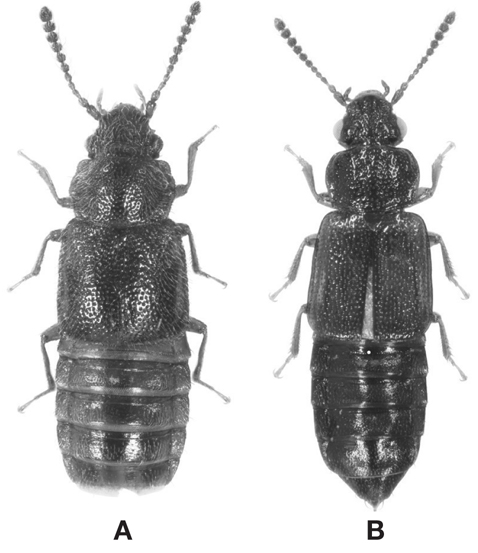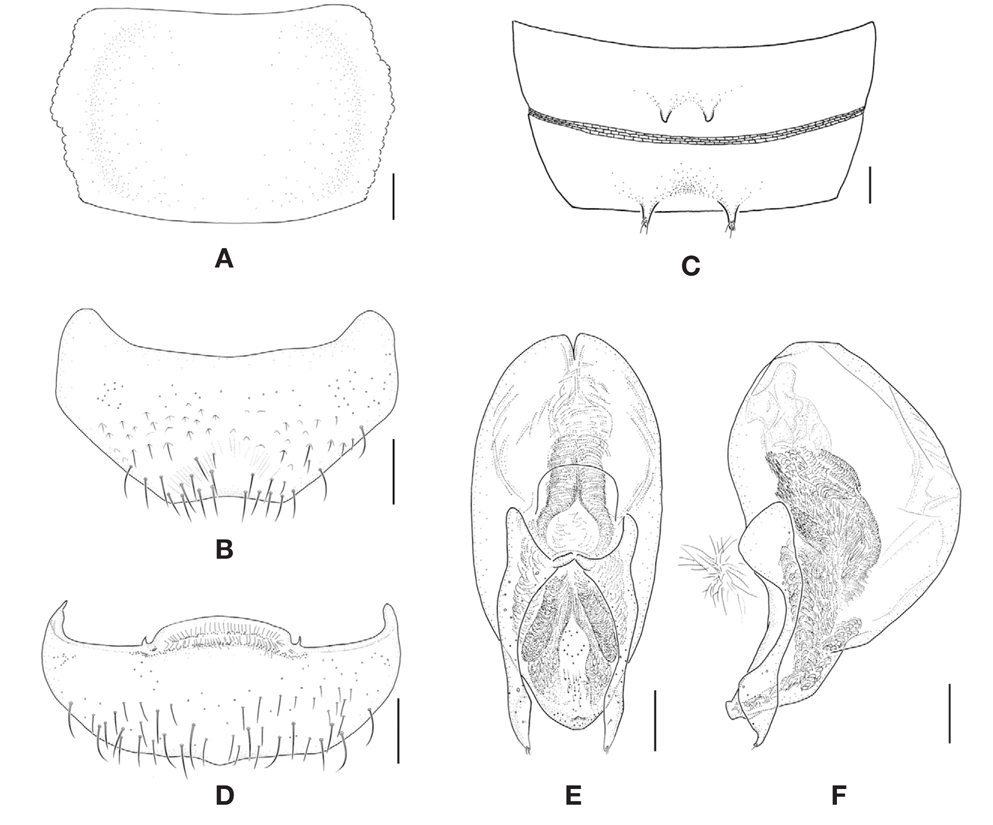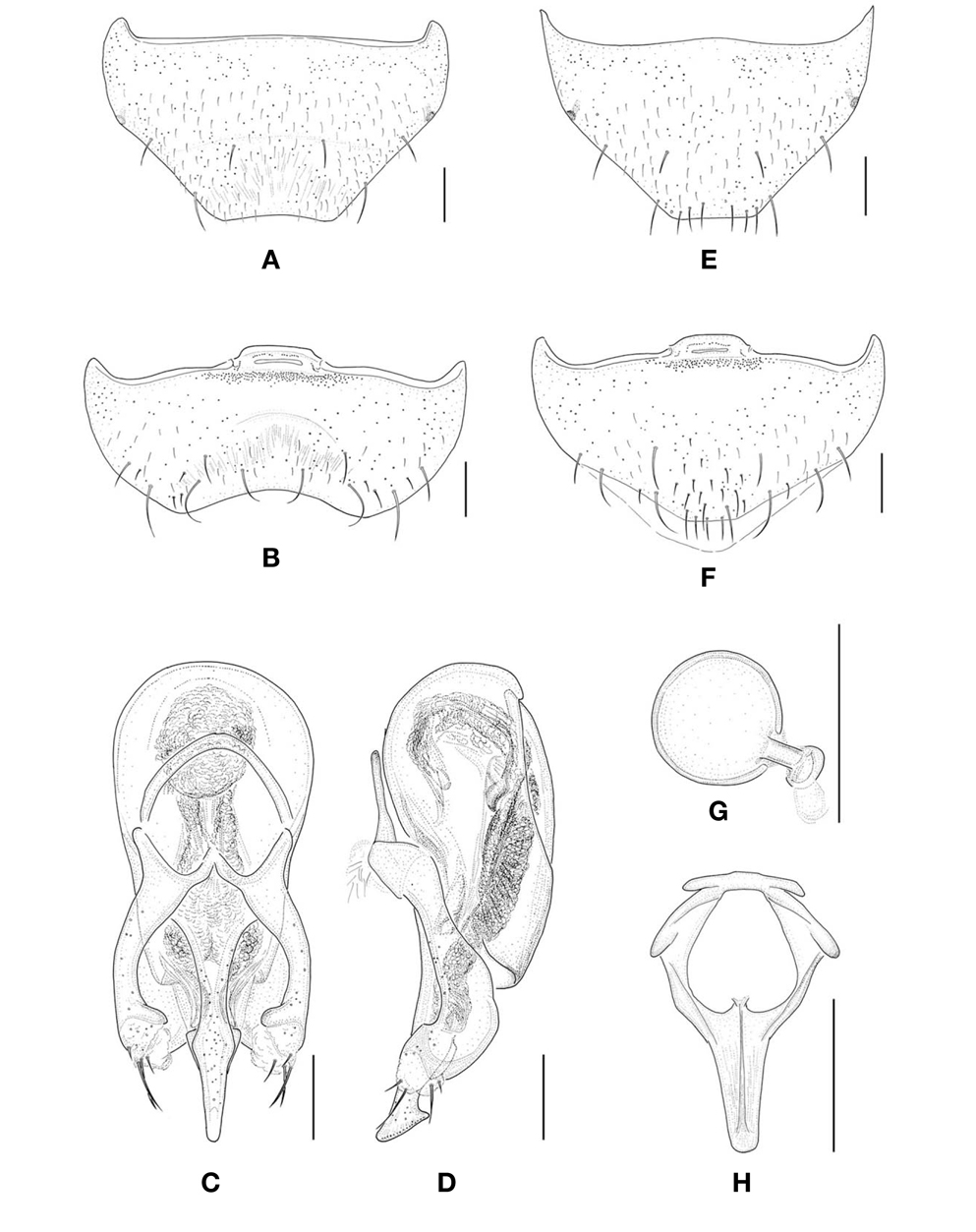



The genera
Little is known about the habitat and behavior of
In this paper, we report
Order Coleoptera Linné, 1758 Family Staphylinidae Latreille, 1802 Subfamily Omaliinae MacLeay, 1825
Genus 1*Acruliopsis Zerche, 2003
Type species:
Diagnosis. Body more or less convex and parallel-sided, covered with coarse punctures and pubescence; maxillary palpomere 4 almost as wide as and about three times longer than 3; antenna relatively short and gradually incrassate distally; eye large and protruded, ocular ridge surrounding eye; ocelli distinct and apart widely; gular sutures divergent posteriorly; pronotum convex medially and transverse, lateral margin crenulate; mesocoxal cavities separated; abdominal tergite VII with apical palisade fringe; sternite III with conspicuous intercoxal process, transverse carina present and anterior half beyond carina impressed (Zerche, 2003).
2*Acruliopsis ussuriensis Zerche, 2003 (Figs. 1A, 2)
Material examined. Korea: 1♂, Gangwon Prov.: Inje-gun, Girin-myeon, Jindong-ri, Mt. Jeombongsan, 18 Apr 2007, Kim YH, under bark (CNUIC); 1♂, Pyeongchang-gun, Jinbu- myeon, Dongsan-ri, Mt. Odaesan, Sangwonsa, 16 Aug- 15 Sep 2001, Park SJ, Shin CW,
Description. Body length 2.3-2.6 mm (head to abdominal end), body brown to dark reddish brown and lustrous, appendages yellow to reddish brown, anterior part of pronotum and humeral region of elytra weakly brighter. Head broad, pentagonal, punctate sparsely and coarsely, about 1.3 times wider than long; eye about 2.3 times longer than temple; distance between ocelli about 1.8 times wider than distance between outside of ocellus and inner margin of eye; antennae reaching to anterior third of elytra; basal five antennomeres lustrous and remaining lusterless; scape robust, about 1.8 times longer than wide; pedicel ovoid, about 1.4 times longer than wide, slightly shorter and narrower than scape; antennomere 3 slender, slightly dilated apically, 1.3 times longer than wide, slightly shorter and narrower than pedicel; 4-5 ovoid, almost same in length and shape each other, about 1.4 times longer than wide; 6 subglobular, slightly longer than wide; 7-9 subpentagonal, slightly getting shorter and wider distally, about 1.06-1.20 times wider than long; 10 trapezoidal, about 1.3 times wider than long, slightly shorter than 9; 11 about 1.3 times longer than wide. Pronotum (Fig. 2A) subhexagonal transversely, convex medially and deplanate laterally, covered with punctures much coarser than head; lateral margin sinuated with crenulation, widest near middle, 1.6 times wider than long, about 1.4 times wider and 1.2 times longer than head; anterior margin almost straight, posterior margin arcuate; anterior angles obtuse and posterior one more or less angulate; posterior third of deplanate area more or less depressed. Elytra more or less convex laterally, punctate coarsely and densely, about 1.3 times wider than long, about 1.2 times wider and 1.5 times longer than pronotum; posterior margin truncated, lateral margin crenulated excluding posterior fourth; prosternal process long and acute with short carina longitudinally; ventral surface of middle tibia with about five or six granules arranged; ventral surface of metatibia roundly and shallowly excavated in apical two third. Abdomen punctate finely and sparsely, surface with dense reticulate microsculpture; tergite IV with pair of transverse oval patches of wing-folding spicules.
Male. Abdominal tergite VIII (Fig. 2B) narrowed posteriorly with truncated but weakly emarginated posterior margin; pair of small and obtuse processes present on posterior third of sternite VI, projecting postero-ventrally (Fig. 2C); conspicuous and acute processes present just before posterior margin of sternite VII, projecting postero-ventrally with apical setae, distance between them almost twice as wide as distance on sternite VI (Fig. 2C); sternite VIII (Fig. 2D) narrowed posteriorly, more or less extended triangularly. Aedeagus (Fig. 2E, F) trilobed; median lobe robust, gently narrowed apically with round apex; parameres little longer than median lobe, apical half of paramere constricted and curved inwardly, apical part expanded and inner surface excavated roundly.
Distribution. Korea, Russia (Far East).
1*Genus Omalium Gravenhorst, 1802
Type species:
Diagnosis. Body more or less depressed, elongate and parallel- sided, covered with more or less coarse punctures; oblique short furrow or depression present in front of each ocellus; maxillary palpomere 4 almost as wide as and about two times longer than 3; mentum with pair of long setae on each side of posterior fourth; antennae gradually incrassate distally, antennomeres 8-10 transverse; pronotum with paired longitudinal depressions on posterior third; mesoventrite with longitudinal carina along midline; mesocoxal cavities separated; metatarsomere 5 longer than basal 4 combined; abdominal tergite VII with apical palisade fringe (Zanetti, 1987, Watanabe, 1990).
1*Omalium japonicum Sharp, 1874 (Figs. 1B, 3, 4)
Material examined. Korea: 1♂, Gangwon Prov.: Samcheok- si, Wondeok-eup, Hosan-ri, 28 Apr 1985, Kim YS, under seaweed (CNUIC); 52♂38♀ (in EtOH), Chungbuk Prov.: Yeongdong-gun, Hwanggan-myeon, 36°11′23.8′′N, 127°53′44.3′′E, 248 m, 18 May 2011, Kim TK, sifting, decaying food (CNUIC); 6♂1♀ (1♂1♀ on slides; 4♂ in EtOH), Chungnam Prov.: Gongju-si, Banpo-myeon, Mt. Gyeryongsan, 36°21′17.5′′N, 127°14′55.6′′E, 26 Apr 2005, Park JS, Lee SI, food garbage (CNUIC); 5♂2♀ (1♂ on slide; 4♂2♀ in EtOH), Gongju-si, Janggi-myeon, 36°29′ 25.1′′N, 127°14′11.3′′E, 70 m, 8 May 2010, Lee SG, Jeon JH, food garbage (CNUIC); 3♀ (1♀ on slide; 2♀ in EtOH), Seosan- si, Unsan-myeon, Yonghyeon Valley, 36°45′5.7′′N, 126°36′28′′E, 170 m, 16 Apr 2009, Kim YH, Song JH, fungus on log and leaf litter (CNUIC); 2♂ (in EtOH), Unsan- myeon, Mt. Illaksan, 36°44′29.2′′N, 126°35′6.3′′E, 123 m, 16 Apr 2009, Song JH, Lee SG, carrion (CNUIC); 1♂3♀ (1♂ on slide; 3♀ in EtOH), Jeonbuk Prov.: Gochang-gun, Haeri-myeon, Goseong-ri, 35°26′40.7′′N, 126°33′0.6′′E, 1 May 2007, Kim TK, Kim YH, under manure (CNUIC); 1♀, Jeonnam Prov.: Gurye-gun, Mt. Jirisan, Piagol, 24-26 May 2000, Choi HK, Song JH, Kim MS,
Description. Body length 2.7-3.2 mm (head to abdominal end), body dark brown, elytra and appendages yellowish brown to reddish brown. Head subpentagonal, covered with scattered coarse punctures, about 1.4 times wider than long; eye about 3.8 times longer than temple; distance between outside of ocellus and inner margin of eye about 1.3 times wider than distance between ocelli; antennae (Fig. 3E) reaching to posterior margin of pronotum, basal five antennomeres lustrous and remaining lusterless; scape robust, about 1.8 times longer than wide; pedicel ovoid, about 1.4 times longer than wide, relatively shorter and slightly narrower than scape; antennomere 3 more or less slender, slightly dilated apically, about 1.6 times longer than wide, slightly longer and narrower than pedicel; 4-5 subglobular, almost as wide as long; 6-10 subpentagonal and transverse, getting larger distally; 6-7 about 1.1 times wider than long; 8-10 about 1.2 times wider than long; 11 about 1.5 times longer than wide. Pronotum subquadrate transversely; lateral margin arcuate, widest anterior third, about 1.4 times wider than long, 1.3 times wider and longer than head; anterior margin almost straight, posterior margin arcuate; anterior angles subround and posterior one more or less angulate. Scutellum (Fig. 3F) heart-shaped, covered with scattered punctures and indistinct microsculpture. Elytra (Fig. 3G) covered with punctures and pubescence, lateral margin straight and almost parallel-sided, posterior margin truncated, slightly wider than long, 1.2 times wider and 1.6 times longer than pronotum; all tarsi with basal 4 combined shorter than tarsomere 5, metatarsomere 5 about 1.4 times longer than basal 4 combined. Abdomen subparallel; pair of suboval patches of wing folding spicules present on tergite IV.
Male. Protarsus more or less wide; abodominal tergite VIII (Fig. 4A) narrowed posteriorly, posterior margin weakly emarginate; sternite VIII (Fig. 4B) narrowed posteriorly, posterior margin broadly emarginate. Aedeagus (Fig. 4C, D) trilobed and symmetrical, median lobe more or less slender, swollen around middle; parameres shorter than median lobe, curved inwardly, lateral part rolling, apical part membranous with four apical setae.
Female. Abdominal tergite VIII (Fig. 4E) narrowed posteriorly with truncated posterior margin; sternite VIII (Fig. 4F) narrowed posteriorly with truncated posterior margin. Spermatheca (Fig. 4G) subglobular with attached tubule; accessory sclerite (Fig. 4H) widest at anterior third and narrowed posteriorly with blunt apex, medial part opened like inverted heart-shape, posterior half carinate longitudinally.
Distribution. Korea, Japan.



